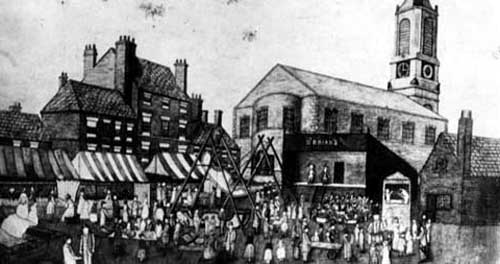|
NGR Class K 0-6-0ST
The Natal Government Railways Class K 0-6-0ST of 1880 was a South African steam locomotive from the pre- Union era in the Colony of Natal. In 1880, the Natal Government Railways placed a single saddle-tank locomotive in service. It was virtually identical to the Harbour Board of Natal's locomotive ''John Milne'' of 1879 and was built by the same manufacturer. During 1905 or 1906, the locomotive was designated .''The Railway Report for year ending 31 Dec. 1904'', Natal Government Railways, Annexure B, Durban, January 1905. NGR Class K of 1879, John Milne & no. 15''The Railway Report for year ending 31 Dec. 1906'', Natal Government Railways. Manufacturer In 1880, the Natal Government Railways (NGR) placed an order for a single saddle-tank locomotive with Hunslet Engine Company in Leeds. It was virtually identical to the engine ''John Milne'' which had been supplied to the Harbour Board of Natal from the same manufacturer in 1879, having been built to the same design, but w ... [...More Info...] [...Related Items...] OR: [Wikipedia] [Google] [Baidu] |
Hunslet Engine Company
The Hunslet Engine Company is a locomotive-building company, founded in 1864 in Hunslet, England. It manufactured steam locomotives for over 100 years and currently manufactures diesel shunting locomotives. The company is part of Ed Murray & Sons. History The early years 1864–1901 The company was founded in 1864 at Jack Lane in Hunslet by John Towlerton Leather, a civil engineering contractor, who appointed James Campbell (son of Alexander Campbell, a Leeds engineer) as his works manager. The first engine was completed in 1865. It was ''Linden'', a standard gauge delivered to Brassey and Ballard, a railway civil engineering contractor as were several of the firm's early customers. Other customers included collieries. This basic standard gauge shunting and short haul "industrial" engine was to be the main-stay of Hunslet production for many years. In 1871, James Campbell bought the company for £25,000 (payable in five instalments over two years) and the firm rema ... [...More Info...] [...Related Items...] OR: [Wikipedia] [Google] [Baidu] |
NGR Class K 0-4-0ST
The Natal Government Railways Class K 0-4-0ST of 1891 was a South African steam locomotive from the pre-Union of South Africa, Union era in the Colony of Natal. In 1891, the Natal Government Railways placed five locomotives in service as shunting engines. One was later sold to the Pretoria-Pietersburg Railway, while two more went to the Harbour Board of Natal. In 1905 or 1906, the remaining two of these locomotives became part of the Natal . By 1912, four of these locomotives survived to come onto the roster of the South African Railways as unclassified obsolete locomotives.''The Railway Report for year ending 31 Dec. 1906'', Natal Government Railways.Espitalier, T.J.; Day, W.A.J. (1944). ''The Locomotive in South Africa - A Brief History of Railway Development. Chapter III - Natal Government Railways'' (Continued). South African Railways and Harbours Magazine, September 1944. p. 670. Manufacturer Five shunting locomotives were delivered to the Natal Government Railways (NG ... [...More Info...] [...Related Items...] OR: [Wikipedia] [Google] [Baidu] |
Railway Locomotives Introduced In 1880
Rail transport (also known as train transport) is a means of transport that transfers passengers and goods on wheeled vehicles running on rails, which are incorporated in tracks. In contrast to road transport, where the vehicles run on a prepared flat surface, rail vehicles (rolling stock) are directionally guided by the tracks on which they run. Tracks usually consist of steel rails, installed on sleepers (ties) set in ballast, on which the rolling stock, usually fitted with metal wheels, moves. Other variations are also possible, such as "slab track", in which the rails are fastened to a concrete foundation resting on a prepared subsurface. Rolling stock in a rail transport system generally encounters lower frictional resistance than rubber-tyred road vehicles, so passenger and freight cars (carriages and wagons) can be coupled into longer trains. The operation is carried out by a railway company, providing transport between train stations or freight customer facilit ... [...More Info...] [...Related Items...] OR: [Wikipedia] [Google] [Baidu] |
Cape Gauge Railway Locomotives
A cape is a clothing accessory or a sleeveless outer garment which drapes the wearer's back, arms, and chest, and connects at the neck. History Capes were common in medieval Europe, especially when combined with a hood in the chaperon. They have had periodic returns to fashion - for example, in nineteenth-century Europe. Roman Catholic clergy wear a type of cape known as a ferraiolo, which is worn for formal events outside a ritualistic context. The cope is a liturgical vestment in the form of a cape. Capes are often highly decorated with elaborate embroidery. Capes remain in regular use as rainwear in various military units and police forces, in France for example. A gas cape was a voluminous military garment designed to give rain protection to someone wearing the bulky gas masks used in twentieth-century wars. Rich noblemen and elite warriors of the Aztec Empire would wear a tilmàtli; a Mesoamerican cloak/cape used as a symbol of their upper status. Cloth and clothin ... [...More Info...] [...Related Items...] OR: [Wikipedia] [Google] [Baidu] |
Hunslet Locomotives
Hunslet () is an inner-city area in south Leeds, West Yorkshire, England. It is southeast of the Leeds city centre, city centre and has an industrial past. It is situated in the Hunslet and Riverside (ward), Hunslet and Riverside ward of Leeds City Council and Leeds Central (UK Parliament constituency), Leeds Central parliamentary constituency. The population of the previous City and Hunslet council ward at the 2011 census was 33,705. Many engineering companies were based in Hunslet, including John Fowler & Co. manufacturers of traction engines and steam rollers, the Hunslet Engine Company builders of locomotives (including those used during the construction of the Channel Tunnel), Kitson & Co., Manning Wardle and Hudswell Clarke. Many railway locomotives were built in the Jack Lane area of Hunslet. The area has a mixture of modern and 19th century industrial buildings, terraced house, terraced housing and 20th century housing. It is an area that has grown up significantly a ... [...More Info...] [...Related Items...] OR: [Wikipedia] [Google] [Baidu] |
C Locomotives
C, or c, is the third letter in the Latin alphabet, used in the modern English alphabet, the alphabets of other western European languages and others worldwide. Its name in English is ''cee'' (pronounced ), plural ''cees''. History "C" comes from the same letter as "G". The Semites named it gimel. The sign is possibly adapted from an Egyptian hieroglyph for a staff sling, which may have been the meaning of the name ''gimel''. Another possibility is that it depicted a camel, the Semitic name for which was ''gamal''. Barry B. Powell, a specialist in the history of writing, states "It is hard to imagine how gimel = "camel" can be derived from the picture of a camel (it may show his hump, or his head and neck!)". In the Etruscan language, plosive consonants had no contrastive voicing, so the Greek ' Γ' (Gamma) was adopted into the Etruscan alphabet to represent . Already in the Western Greek alphabet, Gamma first took a '' form in Early Etruscan, then '' in Classical ... [...More Info...] [...Related Items...] OR: [Wikipedia] [Google] [Baidu] |
Individual Locomotives Of South Africa
An individual is that which exists as a distinct entity. Individuality (or self-hood) is the state or quality of being an individual; particularly (in the case of humans) of being a person unique from other people and possessing one's own needs or goals, rights and responsibilities. The concept of an individual features in diverse fields, including biology, law, and philosophy. Etymology From the 15th century and earlier (and also today within the fields of statistics and metaphysics) ''individual'' meant " indivisible", typically describing any numerically singular thing, but sometimes meaning "a person". From the 17th century on, ''individual'' has indicated separateness, as in individualism. Law Although individuality and individualism are commonly considered to mature with age/time and experience/wealth, a sane adult human being is usually considered by the state as an "individual person" in law, even if the person denies individual culpability ("I followed ... [...More Info...] [...Related Items...] OR: [Wikipedia] [Google] [Baidu] |
NGR Locomotives in England
{{Disambig ...
NGR may refer to: *Natal Government Railways * Nepal Government Railway *New Generation Rollingstock operated by Queensland Rail, Australia *Nigeria (International Olympic Committee country-code) *North Gloucestershire Railway The Toddington Narrow Gauge Railway (''TNGR'') is a narrow-gauge railway running alongside the Gloucestershire and Warwickshire Railway at . It was built in 1985 when the Dowty Railway Preservation Society needed a new home for its collectio ... [...More Info...] [...Related Items...] OR: [Wikipedia] [Google] [Baidu] |
NGR Class K 2-6-0T
The Natal Government Railways Class K 2-6-0T of 1877 was a South African steam locomotive from the pre- Union era in the Natal Colony. The Natal Government Railways was established in terms of Act 4 of 1875. All the assets of the Natal Railway Company were taken over by the Colonial Government and became part of the new Railways with effect from 1 January 1877. On 1 June 1877, William Milne was appointed as the Railway's first Locomotive Superintendent. To cope with the anticipated traffic on the new Cape gauge line which was being built inland from Durban to Pietermaritzburg, Milne placed an order for seven new locomotives. In 1905 or 1906, the survivors of these locomotives became part of the Natal .''The Railway Report for year ending 31 Dec. 1904'', Natal Government Railways, Annexure B, Durban, January 1905.Espitalier, T.J.; Day, W.A.J. (1944). ''The Locomotive in South Africa - A Brief History of Railway Development. Chapter III - Natal Government Railways''. South Afr ... [...More Info...] [...Related Items...] OR: [Wikipedia] [Google] [Baidu] |
South African Class C 4-6-0T
The South African Railways Class C 4-6-0T of 1879 was a steam locomotive from the pre-Union of South Africa, Union era in the Colony of Natal. Between 1879 and 1885, the Natal Government Railways placed thirty-seven Ten-wheeler type tank steam locomotives in service. Of these, the first seven were built as Mogul type locomotives and were subsequently modified to a wheel arrangement. By 1908 they were designated Class G and in 1912, when some of the survivors were assimilated into the South African Railways, they were renumbered and reclassified to Class C. These were the oldest pre-Union locomotives to be classified and renumbered onto the SAR roster.Classification of S.A.R. Engines with Renumbering Lists, issued by the Chief Mechanical Engineer's Office, Pretoria, January 1912, pp. 7, 13, 19 (Reprinted in April 1987 by SATS Museum, R.3125-6/9/11-1000) Origins In 1875, when the Natal Government took over all the assets of the Natal Railway Company and formed the Natal Govern ... [...More Info...] [...Related Items...] OR: [Wikipedia] [Google] [Baidu] |
0-6-0
Under the Whyte notation for the classification of steam locomotives, represents the wheel arrangement of no leading wheels, six powered and coupled driving wheels on three axles and no trailing wheels. This was the most common wheel arrangement used on both tender and tank locomotives in versions with both inside and outside cylinders. In the United Kingdom, the Whyte notation of wheel arrangement was also often used for the classification of electric and diesel-electric locomotives with side-rod coupled driving wheels. Under the UIC classification, popular in Europe, this wheel arrangement is written as C if the wheels are coupled with rods or gears, or Co if they are independently driven, the latter usually being electric and diesel-electric locomotives. Overview History The 0-6-0 configuration was the most widely used wheel arrangement for both tender and tank steam locomotives. The type was also widely used for diesel switchers (shunters). Because they lack leading and ... [...More Info...] [...Related Items...] OR: [Wikipedia] [Google] [Baidu] |







.jpg)